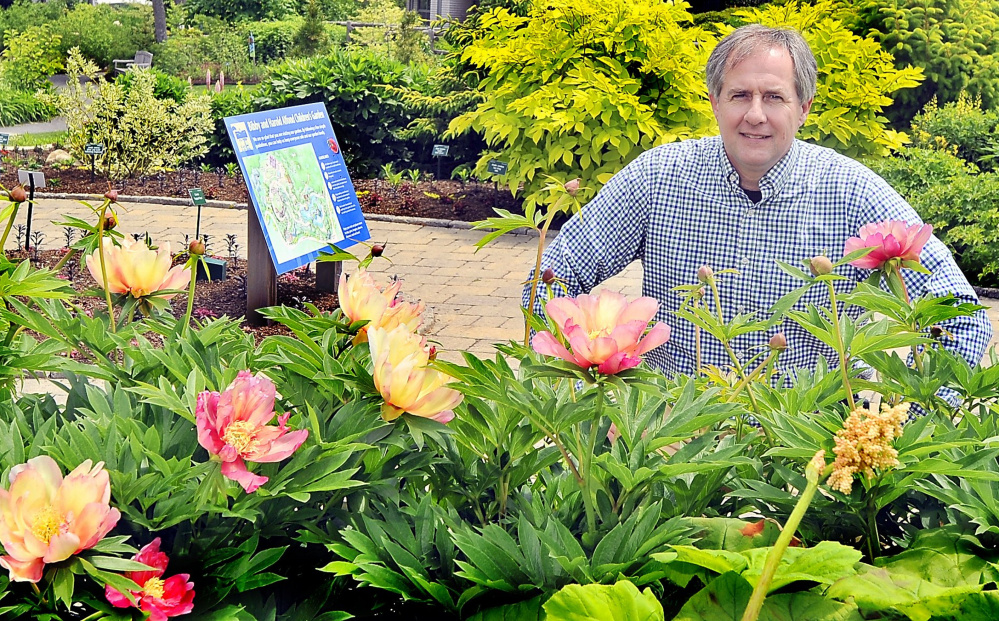Coastal Maine Botanical Gardens is planning to start work in the summer of 2017 on what would be the largest conservatory in New England.
If all goes well, the project would be completed in 2018, William Cullina, the garden’s executive director, said in a telephone interview.
The conservatory is the most dramatic of a series of projects that would double the size of the intensely developed sections of the 270-acre property by 2020. Among the other projects, a new water-themed display garden would connect the parking lots with the conservatory and with a new, larger visitor center. The current visitor center would be remodeled to house several restaurants. Classroom space at the botanical garden would expand and include a so-called dirty classroom where visitors could work on plant and garden projects.
But the project Cullina is particularly excited about is one that most visitors would never see.
“The other key thing is to build a proper propagations and research facility,” he said, “including a 20,000-square-foot fixed greenhouse and hoop houses designed for plant production rather than plant display. Right now we’re like a restaurant without a kitchen – running this garden without growing our own plant material.” Cullina said the expansion is needed to handle the ever increasing number of visitors, which reached about 115,000 this year. The garden was built to handle 35,000 to 40,000 visitors a year, a number it exceeded its very first year. Cullina’s big fear is that people will come and find it too crowded. With the expansion, he says, the garden could comfortably accommodate 300,000 visitors a year.
Squeezing the construction on all these projects into a five-year window will allow economies of scale in doing the concrete, electric and other work at once, Cullina said. It will also create some challenges as the garden staff works to ensure that visitors aren’t bothered by construction noise and dust. The fact that the garden will be closed from January through mid-April (at least until 2018) will let construction to proceed more smoothly.
The existing garden was completed between 2006 to 2011, Cullina said, and the expansion will be similar in scale. About 15 months ago, Cullina announced that a Virginia landscape architect firm had been hired to develop a design for the expansion; these proposed projects are the result, and staff have already begun applying for local, state and federal permits.
The expansion will grow both the garden’s economic footprint and its reputation as one of the nation’s top botanical gardens. Cullina noted that Butchart Gardens on Vancouver Island in British Columbia is even harder to reach than Boothbay, and it gets 800,000 visitors a year – including tourists on charter flights from China.
Coastal Maine Botanical Gardens was named TripAdvisor’s top botanical garden in the United States in 2013 and has received praise from such horticultural superheroes as Michael Dirr and Allan Armitage. The expansion is intended to improve the garden’s reputation and help it reach Cullina’s stated goal of visitors to Maine having three items on their vacation agenda (and not necessarily in this order):
1) L.L. Bean
2) Acadia National Park
3) The botanical garden
Personally speaking, I am most excited about the conservatory. From Kew Gardens in London to Callaway Gardens in Georgia, I always enjoy the separate environment that these buildings create.
The Coastal Maine Botanical Gardens conservatory will be located in what is now the garden’s main parking area. It is planned to have three sections for a total of 30,000 square feet. The center will be about 60 feet tall, with shorter wings on each end.
“Whenever you talk about a conservatory, people tend to roll their eyes and say, ‘That’s a really expensive project,’ ” Cullina said.
And at an estimated $7 million, it is not cheap. But he thinks – hopes – he can keep the cost to about $300 per square foot as compared to the usual $800 to $1,000. He’s also considering extra layers of insulation to reduce heating costs.
The conservatory will have no permanent plants, Cullina said, but different displays will be moved in and out during the year. In the summer, it will be used as a butterfly house (Don’t look for tropical butterflies, though; they require too much care in Maine).
In the winter, holiday displays will be created, and the plants will be more like those that grow in California.
“Even at 55 or 60 degrees, it would be a lot warmer than any other garden in New England during winter,” he said.
The new display gardens will include a meandering stream and feature a 1,000-foot serpentine stone wall made of different materials, which is designed to be representative of the Maine coast’s many peninsulas and bays. The wall will create many opportunities for room-like gardens. Cullina expects to raise money for the project from private foundations and families, two groups that donated the funds to develop the garden originally.
In the 1990s, the Coastal Maine Botanical Garden existed only as a waterfront parcel and some big dreams. I remember the excited anticipation for the grand opening in 2007. Every garden is interesting in its own way, and Coastal Maine Botanical Gardens is spectacular now. But I expect the same kind of fervor to build over the next few years as the property blossoms even more gloriously.
TOM ATWELL has been writing the Maine Gardener column since 2004. He is a freelance writer gardening in Cape Elizabeth and can be contacted at 767-2297 or at tomatwell@me.com.
Send questions/comments to the editors.



Comments are no longer available on this story